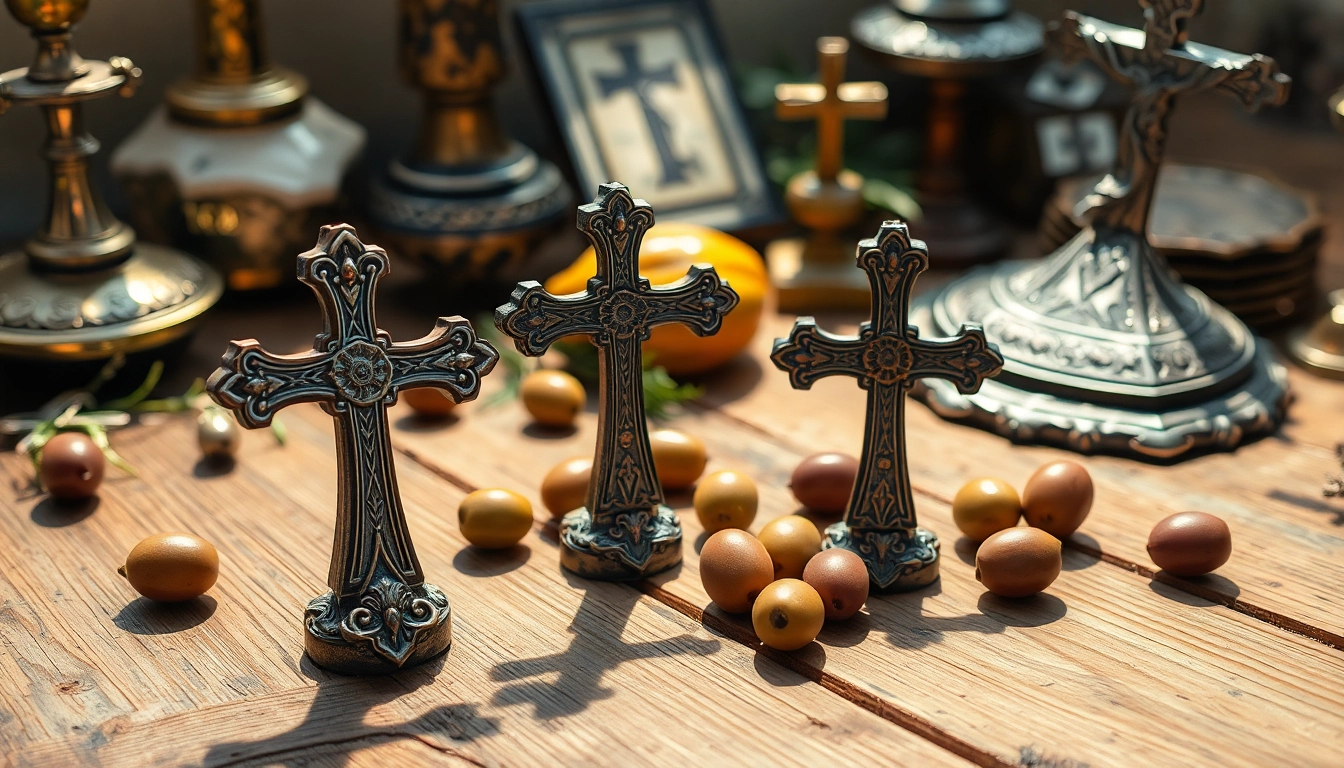The Historical Background of Jerusalem Crosses
Origins and Evolution
The Jerusalem cross, also known as the “Crusader’s Cross,” boasts a rich history steeped in symbolism and tradition. Its origins can be traced back to the 11th century during the time of the Crusades. The design, characterized by a large central cross featuring four smaller crosses in each quadrant, represents a unique blend of faith, culture, and artistry. Within the framework of Christianity, this emblem was adopted by the Crusaders as a symbol of their conquests and, more importantly, as a representation of their commitment to spreading Christianity beyond the Holy Land.
Over the centuries, the Jerusalem cross has evolved, adapting to various cultural contexts while retaining its core symbolisms. The larger cross signifies Christ’s central role in the Christian faith, while the four smaller crosses are often interpreted as representing the Four Evangelists—Matthew, Mark, Luke, and John—who propagated the teachings of Jesus across different parts of the world.
Symbolism Behind the Design
The design of the Jerusalem cross is rich in meaning. The large cross stands as the primary symbol of Jesus Christ and His sacrifice, while the four smaller crosses reflect the preaching of His message to the four corners of the earth. This dual structure not only signifies the global reach of Christianity but also highlights the enduring impact of its core teachings.
Furthermore, there are diverse interpretations of the smaller crosses. Some traditions suggest that they symbolize the four cardinal directions, symbolizing the outreach of Christianity across the globe, while others view them as emblematic of the myriad challenges that accompany faith. Regardless of the interpretation, the Jerusalem cross serves as a powerful reminder of the fundamental tenets of Christianity: hope, redemption, and the call to share God’s message with the world.
The Role in Christian Traditions
The Jerusalem cross holds significant weight in Christian tradition, especially within Catholic and Orthodox communities. It is often used in liturgical practices, educational settings, and as a motif in Christian art and iconography. The cross’s relationship with the promises of God and the teachings of Jesus makes it a central element in many church programs and services.
In addition to its religious significance, the Jerusalem cross has also become a popular symbol in contemporary Christian culture. It can be found in various forms, including jewelry, art pieces, and religious artifacts, serving as a visual reminder of faith and devotion for many believers.
Different Types of Jerusalem Crosses
Materials Used in Craftsmanship
Jerusalem crosses are crafted using a variety of materials, each adding a distinct touch to the design. Traditional artisans often utilize olive wood, a material that carries significant weight in Christian symbolism as the olive tree is frequently associated with peace and fertility. Wooden crosses carved from Bethlehem olive wood are particularly sought after, embodying a piece of the Holy Land’s heritage in every piece.
Other common materials include metals such as gold, silver, and copper, which not only enhance the cross’s aesthetic appeal but also contribute to its durability. These materials are often used to create intricate designs that honor the original symbolism of the Jerusalem cross while appealing to contemporary tastes. Additionally, the use of gemstones can be seen, adding a layer of opulence and personal connection for those who wear or display these crosses.
Modern Variants and Interpretations
In recent years, the Jerusalem cross has encountered various modern interpretations that align with contemporary values and aesthetics. From minimalist designs to those that include elaborate engravings, these crosses reflect a diverse range of artistic expressions while preserving their core spiritual meanings.
For instance, some modern variants incorporate elements from regional styles, infusing cultural motifs that resonate with local traditions. This fusion of styles often results in unique pieces that appeal to both collectors and those seeking personal expressions of faith. As the Jerusalem cross continues to adapt, it bridges the gap between historical reverence and modern artistic exploration.
Impact of Regional Styles on Design
The designs of Jerusalem crosses can vary significantly depending on regional influences and artistic styles. Artists draw from their local cultures, incorporating distinctive patterns or motifs that not only reflect their heritage but also enrich the symbolism of the cross itself. For example, artisans in the Middle East may integrate traditional Islamic designs with the cross, creating a unique blend that speaks to the region’s complex history.
Moreover, contemporary artists around the world are beginning to experiment with the Jerusalem cross in new media, such as ceramics, stained glass, and digital art. These innovative approaches help to keep the symbolism of the Jerusalem cross alive while also appealing to younger generations who embrace modern artistic expressions and interpretations.
The Spiritual Significance of Jerusalem Crosses
Meaning of the Five Crosses
The five crosses present in the Jerusalem cross are not merely decorative; they possess deep spiritual meanings. The larger central cross represents Jesus’ crucifixion and His ultimate sacrifice for humanity, emphasizing the gravity and importance of His teachings. This central focus serves as a constant reminder of the love and grace offered to all believers.
Each of the four smaller crosses serves to amplify this message, encapsulating the idea of the missionary spirit inherent in Christianity. By spreading outwards, these crosses symbolize the far-reaching influence of Christ’s message, urging believers to follow in His footsteps and share the Gospel with the world.
Impact on Personal Faith
For many individuals, the Jerusalem cross serves as a personal emblem of their faith. Wearing or displaying the cross can evoke a sense of connection to the history of Christianity and its ongoing relevance in today’s world. It becomes a focal point for contemplation, prayer, and reflection, aiding believers in cultivating their spiritual journeys.
Moreover, the Jerusalem cross can serve as a source of comfort during challenging times. Its enduring symbolism reminds believers that they carry a piece of Christ’s legacy with them, offering solace and strength through moments of doubt or hardship. For many, this personal connection and daily reminder encourage them to embody the love and teachings of Christ in their daily lives.
Usage in Ceremonial Contexts
The Jerusalem cross is often incorporated into various ceremonial contexts within Christian traditions. It plays a significant role in baptisms, weddings, and ordinations, symbolizing the spiritual journey of the individuals involved. During such rituals, the cross signifies not only the commitment to faith but also the communal support that believers offer to one another on their spiritual paths.
Additionally, churches may utilize depictions of the Jerusalem cross in their decor and architecture, serving as visual reminders to congregants and visitors alike of the spiritual heritage and history underlying their faith. Such usage reinforces the importance of the cross within the larger tapestry of Christian rituals and celebrations.
How to Choose the Right Jerusalem Cross
Factors to Consider Before Purchase
Selecting the right Jerusalem cross involves contemplating various factors to ensure its suitability for personal or gifting purposes. Considerations may include size, material, design, and budget. For instance, smaller Jerusalem crosses can be ideal for wearing as jewelry or carrying in one’s pocket, while larger versions may be suited for display in homes or churches.
Another key factor is the material used in crafting the cross, as this can influence not only its aesthetic appeal but also its durability over time. Authenticity is crucial—ascertaining the origin of the cross, particularly if it is made from Bethlehem olive wood or other traditional materials, can enhance its sentimental and spiritual value.
Ultimately, it is essential to reflect on personal sentiments as well. Look for a cross that resonates with the intended message or purpose, whether that be a gift of faith to a loved one or a personal emblem of devotion.
Where to Buy Authentic Jerusalem Crosses
When seeking to purchase a Jerusalem cross, it is vital to source from reputable vendors or artisans known for their dedication to craftsmanship and authenticity. Many established shops in the Holy Land offer a variety of crosses, each imbued with local significance and lovingly crafted by skilled artisans.
Additionally, online marketplaces and specialty retailers that focus on religious artifacts may also provide a selection of authentic Jerusalem crosses. Before purchasing, verify the store’s reputation and take the time to read reviews from other customers to ensure satisfaction with both the product and the shopping experience. For thorough information, consider exploring Jerusalem crosses offerings from trusted establishments.
Recommendations for Gift Giving
Gifting a Jerusalem cross can carry profound significance, especially when tailored to the recipient’s personal beliefs and preferences. When considering a gift, reflect on the individual’s spiritual journey, assessing how the cross might resonate with their faith.
A well-chosen wooden cross could be perfect for someone seeking a piece of heritage that ties them to the land of Jesus. Meanwhile, for someone enthusiastic about contemporary designs, a more modern interpretation may suit their personal taste better. Personalization, such as engraving a meaningful date or phrase, can also add a special touch to the gift, making it even more memorable.
Overall, the intention behind the gift and the thoughtfulness of the choice is what will ultimately make a Jerusalem cross a cherished token for the recipient.
Caring for Your Jerusalem Cross
Maintenance Tips for Longevity
To ensure the longevity of a Jerusalem cross, it is essential to adhere to proper maintenance practices. When choosing a wooden cross, avoid exposure to direct sunlight and extreme humidity, which can lead to warping or fading of the wood. Wiping the surface gently with a soft, dry cloth can help remove dust without damaging the finish.
For metal crosses, regular polishing may be needed to maintain brilliance and prevent tarnishing. Be cautious with chemical cleaners, as they can damage the finish. Instead, opt for mild soap and a soft cloth, ensuring that the cross remains both beautiful and intact over time.
Restoration of Antique Pieces
In cases where an antique Jerusalem cross has sustained damage or wear, restoration can breathe new life into the piece. Seeking the expertise of a professional restoration specialist is key to preserving the integrity and value of the cross. They can provide advice on the best restoration techniques based on the materials and craftsmanship involved.
When considering restoration approaches, it is essential to retain the authentic characteristics of the original piece while addressing superficial issues. For example, refinishing may restore the luster of a wooden cross without altering its historical significance. A delicate balance must be struck to ensure that history is respectfully honored.
Understanding Cultural Sensitivities
Given the Jerusalem cross’s profound history and its ties to religious traditions, it is vital to approach its use and display with cultural sensitivity. For instance, wearing or showcasing the cross in different contexts, such as public spaces or diverse environments, may elicit varying responses. It’s important to recognize and respect the beliefs of others while proudly expressing one’s faith.
Moreover, when gifting a Jerusalem cross to someone from a different cultural background, it may be beneficial to provide context about its history and significance. This effort not only enriches the recipient’s understanding but also elevates the meaningfulness of the gesture, bridging connections between different belief systems and cultural narratives.



